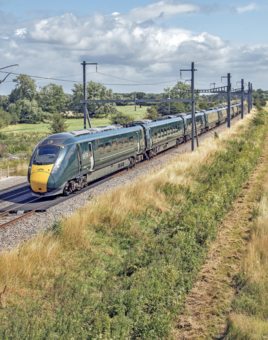Although we waited longer than expected for its arrival, when it came the Transport Decarbonisation Plan didn’t disappoint.
As with many government documents, it left more questions than answers. However, the ‘Greenprint’, as it has been dubbed, did begin to map out where we are heading - particularly when it comes to decarbonisation of the railways.
The paper highlights five key priorities required to deliver a net-zero railway by 2050. First, an ambition to remove all diesel-only trains, both passenger and freight, by 2040. Then a pledge to support the development of battery and hydrogen trains. There was also a need to build extra capacity on the network, and to modernise fares to encourage more people to use the railways.
But the most far-reaching priority - and the one that has got many people talking - is the pledge to deliver what the plan states is “an ambitious, sustainable and cost-effective programme of electrification”.
The programme will be guided by the work already carried out by Network Rail in its Traction Decarbonisation Network Strategy, published last summer. The strategy made it clear that although rail contributes less than 1% of the total UK annual greenhouse gas emissions, it is in the “unique position” of being the only transport mode capable of moving both people and heavy goods using a zero-carbon solution.
The railways aren’t the only transport sector requiring radical changes to meet the net-zero target. Virtually everything that moves will need to shift to a more environmentally friendly mode of operation.
Buses are going electric already, and more towns and cities will receive replacement fleets. Coventry looks set to become the first, with its entire 300-strong fleet going electric as part of government efforts to improve air quality.
Some buses are also being powered by hydrogen. Aberdeen has been the trailblazer, but other cities are now catching up with Birmingham about to launch a fleet of 20 hydrogen buses, and there are already rumours that more could be coming soon.
There’s a conundrum when it comes to commercial traffic. Vans and short-haul lorries are expected to go down the electric vehicle (EV) route, but that’s not the answer for long-distance HGVs. Meanwhile, bulky and heavy batteries could reduce space for cargo, making journeys uneconomic.
Most seem to think the future for long haul is hydrogen. However, there are still issues with the manufacture of the gas - it is still very energy-intensive, and most production currently isn’t particularly green either. Alternative production methods are being developed, but so far few have been proven at scale.
But even with those issues resolved, it’s clear that demand for electricity is set to rise. We need to be prepared.
For the railways, electrification may seem the logical way forward. After all, it’s been the mainstay of a sustainable railway for years. However, providing that reliable green transport isn’t that simple. There are a mix of solutions, and clearly electrification is just one part of an evolving story.
In its initial report back in 2019, the Rail Industry Decarbonisation Taskforce suggested that the greatest challenge on traction was the type of journeys being made.
On some, there are real possibilities for the introduction of new technology, such as hydrogen fuel cells and the use of battery propulsion. Other journeys, such as freight and high-speed inter-city services, have journey characteristics that demand very high energy and power delivery requirements, high acceleration, and long periods between refuelling.
And here, only more electrification can provide what’s needed. As has been learned from the recent upgrade of the Great Western Main Line, electrification isn’t going to be quick or cheap… and there remains the issue of how you get vast amounts of additional power to the parts of the railway where it’s needed.
There have already been many stories about limited capacity for electric vehicle charging, because of issues with local distribution networks. Could the same thing happen when it comes to the power needs of the railways?
There are also issues regarding distribution of the additional power once it reaches Network Rail’s own distribution infrastructure. And even moving the existing fleet of diesel trains that currently operate on electrified routes over to electric traction would need significant reinforcements in certain areas.
As for new electrified railways, Network Rail admits that it is only at the start of the journey.












